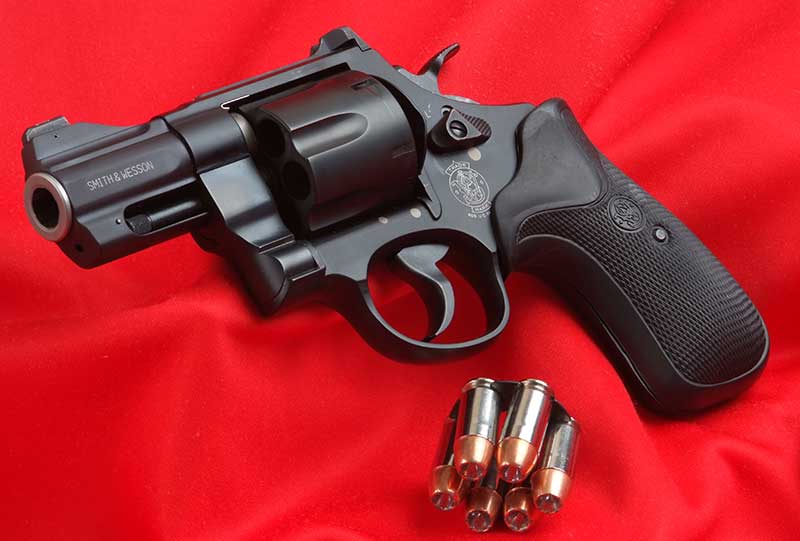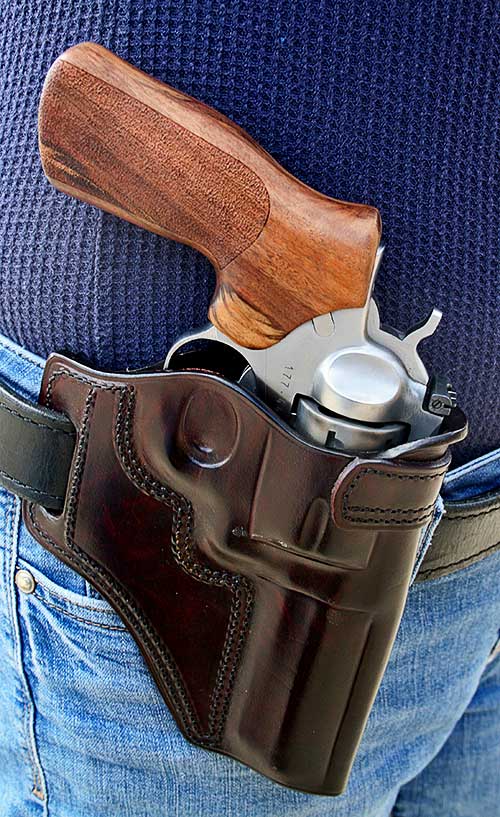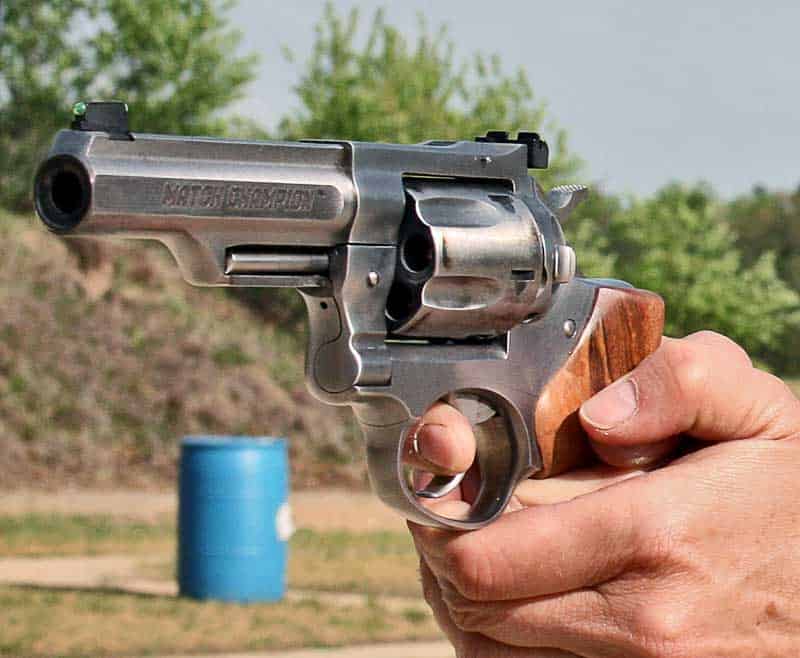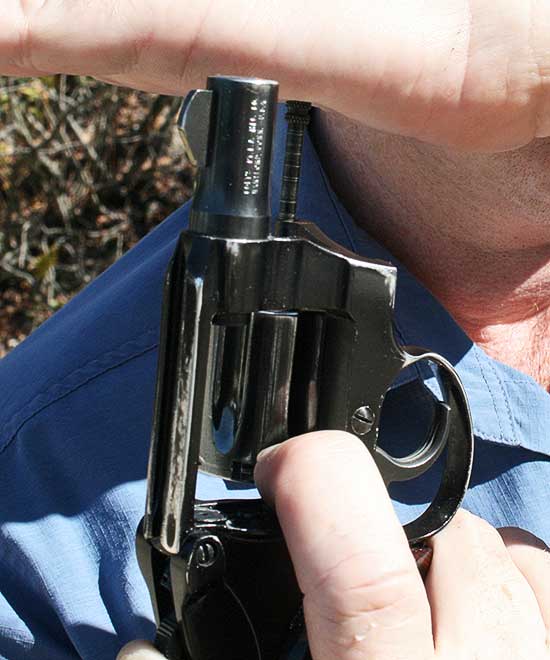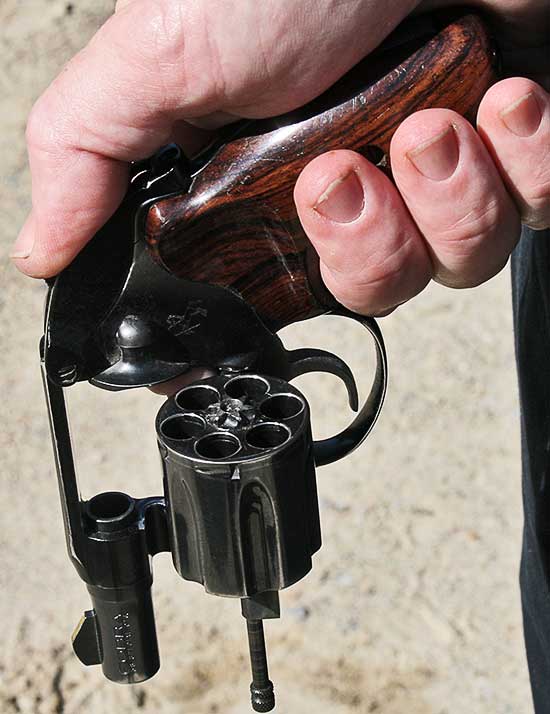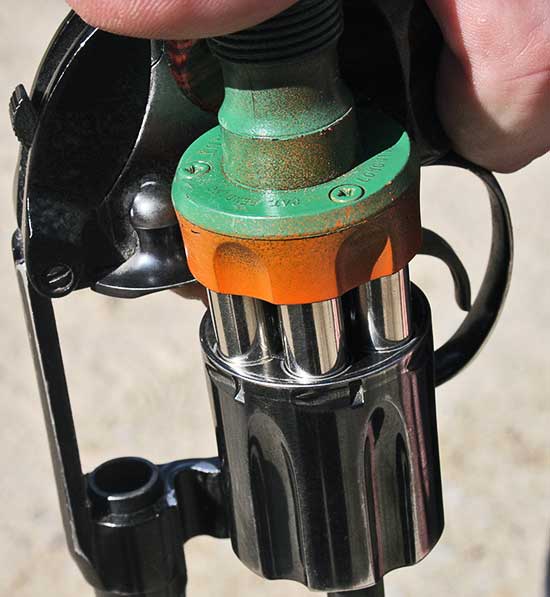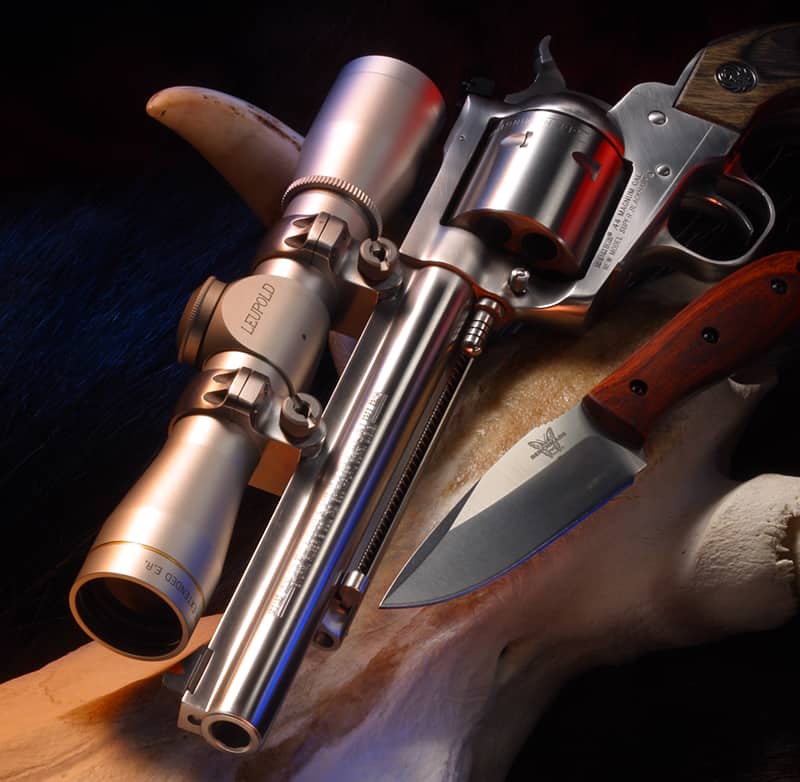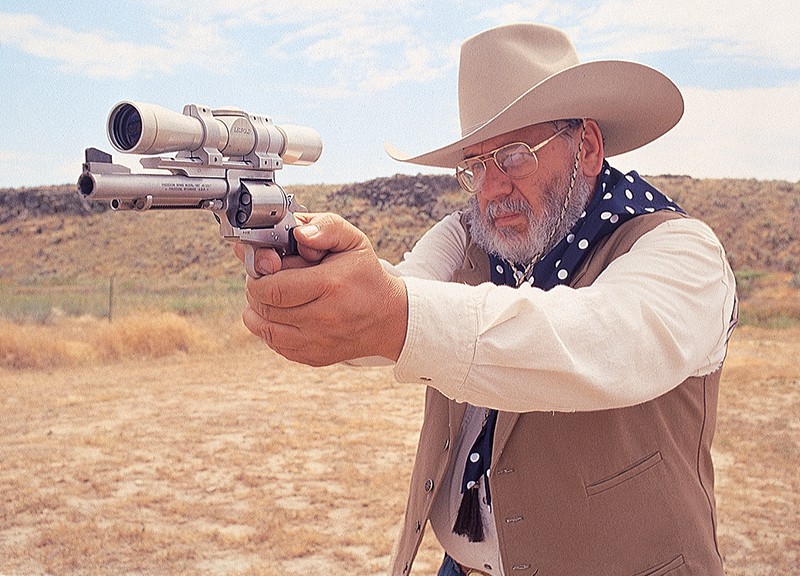Round Gun In A
Square Gun World
There’s Still A Place For Revolvers
Here In The Age Of The Autopistol
I have been called quite a few names over the years, but one label I wear proudly is “old school.” Trends come and go, but I like to look before I leap when it comes to new technology. Unless there is some tangible advantage, I would just as soon stick with something I know is going to work than take my chances with an uncertain future.
When the law enforcement community began the wholesale transition from revolver to semi-autos, I was not an easy sell. But after careful study and analysis, I also came to the conclusion a self-loading pistol was the way to go and became the prime mover within my agency toward making the big switch.
Although revolvers remain a sentimental favorite, I feel the current crop of high-capacity, ultra-reliable semi-autos are better tools for the law enforcement officer and armed citizen. Although pistols now dominate the market, double-action revolvers are still widely used for personal defense and continue to go unseen in the best places.
The demand for revolvers, particularly small-frame models, remains very strong. Like their predecessors, many cops continue to favor a small-frame, snub-nose revolver for backup or off-duty carry. Responsible citizens who carry a firearm for personal defense command an even larger piece of the market. They too have discovered a small revolver can be discreetly carried when wearing any type of clothing or in any social setting. As we shall see, the tried-and-true snubbie holds any number of advantages over a like-size autopistol.
Not Obsolete
There are any number of folks out there who consider the defensive revolver as outmoded as black-and-white TV, disco music and typewriters. Many contemporary “gun guys” really don’t have any frame of reference at all for the revolver. They never owned one or fired one and their revolver experience is limited to watching Adam-12 reruns.
Before dismissing the revolver as obsolete, first consider the role of any defensive handgun. Quite simply, a handgun gives us the ability to establish control over our immediate environment. In all but the most unusual personal defense situations, a revolver is more than capable of this.
All who choose to take up arms for personal defense are not necessarily gun enthusiasts. This is true of many people who have taken responsibility for their own safety. Are your training opportunities going to be very limited? If you can only get out to the range a couple of times a year, the simple-to-understand revolver remains a good choice. It has a very basic manual of arms and it’s easy to understand if it’s loaded or not. Unloading and “verifying empty” is almost as simple.
Cost is also a factor. Although bargain police trade-ins are a lot scarcer these days, some very good deals are still out there. You can still procure a high-quality revolver for less than a comparable-quality autopistol. Plus, speedloaders and strips cost less than extra magazines. The end user can also select from an infinite variety of aftermarket grips to get a better fit and ammo selection has never been better.
Street Advantages
In certain real-world scenarios, the revolver actually holds an advantage over the autopistol. Consider a contact shot with the muzzle of your firearm pressed up against the body of your assailant. With a pistol, the slide may be pushed out of battery, effectively preventing the gun from being fired. As much as we would like to avoid this particular dilemma, you may find yourself on the ground or pushed up against a wall or vehicle. Unlike a pistol, multiple contact shots are possible with a revolver. Also, a revolver can be reliably cycled with a less than perfect grip, another feat you can’t duplicate with an autopistol.
Revolvers are indeed reliable tools but I, for one, am not convinced they are any more reliable than a properly maintained service auto with good ammunition and magazines. If you spend enough time on a range, you will eventually see every type of handgun, including revolvers, go down for the count. I would, however, submit snubbie revolvers are far more reliable than the vast majority of like-size pocket autos. Many small pistols are not exactly feed-friendly with anything but ball ammunition.
Shooting Fundamentals
In concept, combat shooting fundamentals between the autopistol and revolver aren’t so different. Stance is pretty much a non-issue and in real-life there is absolutely no guarantee you’ll be standing on your feet. You may be seated behind the wheel of your car or in a fast food restaurant when Mr. Murphy comes to call. But when teaching this fundamental, I suggest utilizing a balanced fighting stance with nose forward of the shoulders and shoulders slightly forward of the hips. The support side foot is slightly forward of the strong side foot, but the upper body is almost square to the threat. The toes point forward. This helps facilitate movement, provides a steady platform and works with both handguns and long guns.
Grip and trigger control tend to be somewhat different critters indeed. In concept, the way we align the sights and obtain a reliable index on a threat remains the same, but sighting equipment on many small-frame revolvers is vastly inferior to autopistols. Let’s consider the issue of grip first.
In my perfect world, I prefer to get a two-hand grip if the situation allows. With a pistol, most of us prefer to get the strong hand as high as possible up on the backstrap and have both thumbs pointing forward with a firm grip. This affords us excellent stability and minimizes lateral dispersion of shots on the target.
However, this trick can’t be performed with a revolver, as the thumb will get burned from hot gases escaping between the forcing cone and cylinder. Instead, I would still take a high grip on the backstrap with the strong hand and wrap the support hand around the opposite grip panel, thumb over strong hand thumbnail. The index finger of the support hand is placed hard under the triggerguard.
Trigger manipulation with a revolver is different than with an autopistol. While there are currently multiple trigger systems utilized with pistols, including traditional DA, DAO, and SA, the SA with the short, striker-fired system seems to be the most popular. These triggers tend to break when 6-7 lbs. of rearward pressure is applied with a relatively short distance of travel and short reset. This is pretty much 180 degrees from a double-action revolver with a long, heavy stroke and full-length reset. My solution is to get some snap caps and dry fire the heck out of your revolver. Trigger control is indeed the most difficult fundamental to master and the learning curve is a little steeper with a revolver than an autopistol. But anyone can get a handle on it with proper practice.
The key to shooting any handgun accurately is lining up the muzzle with what you plan to shoot and holding it as still as possible while you depress the trigger — simple stuff in theory until you factor in hard-to-see sights of a snubbie revolver and a short sight radius. The milled notch rear and front ramp on many revolvers is difficult to define under ideal conditions, in poor light under extreme stress it can be a nightmare.
You may want to consider some sort of sight upgrade so you can get on target quickly. Consider a Big Dot front sight from XS Sights or a fiber-optic front sight from HIVIZ. Point shooting can work if a threat presents a large target and at arms length. I much prefer having a set of sights I can quickly define. Even a coarse or crude alig
Sure And Speedy Reloads
Most firearms incidents involving armed citizens are resolved with few shots being fired and the absolute need to reload is extremely rare. This is true regardless of the system used. You’re more likely to run out of time before running out of bullets. But you still need to be prepared for the worst case.
One advantage an autopistol holds over a revolver is better continuity of fire. Quite simply, the self-loading pistol initially holds more rounds and it is both faster and easier to reload under pressure. Reloads with a revolver are a bit more complicated but it’s a learned skill.
There are a number of speed-loading systems for the DA revolver. Find one you like and practice it.
Regardless of what technique you prefer for the revolver reload, consider this: Short barrel models have correspondingly short extractor rods and are not long enough to reliably kick empty cases clear of the cylinder. Elevate the muzzle and smack the rod smartly with the palm near the base of the thumb. This will reliably void the gun of empty brass.
The tactical reload remains a bone of contention for many shooters and instructors, but I feel it definitely has a place with low-capacity handguns, such as a revolver. Consider your threat is down and you have time, distance, and cover working for you. Do you really want to stand around with a half-empty gun? Open the cylinder and replace only the rounds fired.
My Wife, My Student
Some time ago, my wife advised me she wanted to get serious about shooting a handgun and wanted one of her own. Diane made it quite clear she considered an autopistol the devil’s tool and preferred the DA revolver. Ultimately, we settled on a Ruger GP100 Match Champion with adjustable sights.
For the past several months, we have devoted a few hours every week to training and have made quite a bit of progress. Initial drills included reinforcing the fundamentals and shooting with a degree of precision on small targets just a few yards away. Once a degree of competency was established, I upped the ante and introduced humanoid targets to our training regimen. Of late, we factored in more than one threat, movement, and quick delivery of 2-3 shots.
Practical marksmanship only represents part of the picture and we devoted significant time to reloading and practicing the draw. To compliment her GP100, we selected a Brown Shoe Corp holster from C. Rusty Sherrick Custom Leather. Crafted from horsehide, the Brown Shoe Corp Vertical Carry revolver holster positions the gun in a neutral rake on the belt and allows the gun to be quickly brought into action. Retention is achieved through precise molding of the gun to the holster. As a result, Diane’s draw times are now pretty snappy and the GP100, along with her Rusty Sherrick holster, are a force to be reckoned with.
Not Just Old Guys
Old-guy sentiment aside, revolvers remain extremely practical self-defense tools. Revolvers are simple to understand, available in a wide range of calibers, sizes and barrel lengths. Smaller models strike an ideal balance between size and power. Unlike autopistols, revolvers can be reliably cycled with any bullet shape. New shooters can cut their teeth on light loads and gradually move into the high-performance ammo as their proficiency increases. I really like the fact small-frame revolvers are chambered for a legitimate service cartridge — the .38 Special.
Self-loading pistols will continue to dominate the scene, but don’t sell the revolver short. The person carrying one just might know what to do with it.

Get More Revolver Content Every Week!
Sign up for the Wheelgun Wednesday newsletter here:
